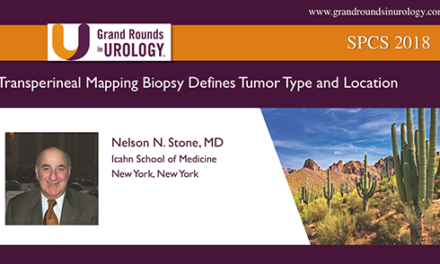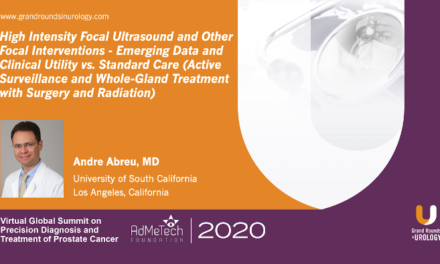Dr. Alan W. Partin spoke at the 25th International Prostate Cancer Update on Thursday, January 22, 2015 on “How Should We Identify Bad Prostate Cancers – Nomograms – An Historical Perspective?.”
Keywords: nomograms, prognosis, Partin tables
How to cite: Partin, Alan W. “How Should We Identify Bad Prostate Cancers – Nomograms – An Historical Perspective?” Grand Rounds in Urology. May 28, 2015. Accessed [todaysdate format=”F j, Y”]. https://dev.grandroundsinurology.com/prostate-cancer-alan-w-partin-identifying-bad-prostate-cancer/.
Transcript
How Should We Identify Bad Prostate Cancers – Nomograms – An Historical Perspective?
One of the most important things we ask ourselves is: can we identify the bad cancers? I want to pull up this cartoon that Paul Lange introduced us to. I sort of keep this in my head when I’m thinking about talking to patients. They want to know if their cancer is a turtle. It’s going to be there whether you come back next year and check it again. Is it a rabbit? If you turn your head and don’t watch it very carefully, it may jump out of the corral. Or is it one of the birds that are going to leave before we even have a chance to pick up our gun?
When you’ve got cancers that are like this, it’s really not difficult for any of us. You don’t need a card, a calculator, an iPad, a Palm Pilot. If you have a patient with a PSA of 100, a big palpable tumor, and a Gleason 8, you know that’s bad. But if they’re a young man with a somewhat elevated PSA, a normal-feeling prostate, and a Gleason 6, you know that one’s not highly aggressive.
It comes down to looking at horses for most of what we’re trying to do. Which horse here is going to win the race? Which cancer cells will win the race? Are these Gleason 6’s that we’re picking up, the old horse that probably can barely get out of the yard he’s in? Or the Gleason 9’s, the stallions that we see running so fast that we can’t catch them.
Do we need to look at our prostate cancers when they’re young? Is there some genetic event in the high-grade pin? Is there some change in the atypical cell, the ASAP? Does 3+3=6 really a cancer? The big question: should we be looking at these pre-malignant lesions to determine what’s going to happen in the future?
Another question. Do we need to see them when they’re moving, the velocity, the density, things that change in time? Are those the critical aspects of what we need to learn about our cancers? Do we need to see them before the race? Do we need to get a SNP analysis on every man when he turns 40? Should we be doing this early screening before they’re at risk for showing up with prostate cancer? We already know family history is very critical.
How much information do we need? Here’s a list of 34 things that you can actually measure on a horse to determine whether they’re going to be good stock and win a lot of races. We almost have as many things in our armamentarium now to determine whether or not prostate cancers are aggressive or not. Every day that list gets bigger.
We used to ask the question: when is it too late? Looking at some of the young surgeons in my department it’s never too late. The Gleason score doesn’t scare him. The palpability. Even the results of the MRI and the bone scan. Is there some combination of these variables that we’re going to determine when it actually is too late to treat patients?
Critical decision making. Three of the most important questions I get confronted with every day in clinic: should I get a biopsy? Or I had a biopsy and it was negative; now what should I do? Or the real important one: my biopsy was positive; what should I do?
Back in 1984 we just had three things we knew about a cancer. It was pretty easy. If they had a palpable lesion, they had prostate cancer. Gleason score didn’t really matter back then. If you had cancer, you had cancer. Then we had the results of the bone scan. 2004, when I started working in the nomogram area, we began to get a lot more other things. We were measuring polity. We were looking at the percent grade 4 and 5. Then just last year we now have three genetic tests: a urine test, a couple of new blood tests. We have MRIs and the list continues to grow. You heard Scott talking about some stuff that’s not even on this slide.
Decisions of whether or not to get a biopsy–the unfortunate problem we heard a lot about this morning, so I won’t dwell on it–is the Preventive Task Force that never get PSAs. The AUA at least gives us a range from 55 to 70, but only check it every two years.
In 2003 the results of the prostate cancer prevention trial showed us that these men with PSAs below 2.5, a high percentage of them actually do have cancer. If it’s less than 1, it was 10%; between 1 and 2 it was 21%; between 2 and 3 it was 31%. Those were not for-cause biopsies. The men just came in for the trial to get looked at.
PSA isn’t really a great marker for determining whether someone should have a biopsy, but it really doesn’t make sense that we made those arbitrary cutoffs of 4.0 because we now know man with a PSA of 3.8 probably has the same probability of having cancer as the man with the PSA of 4.2. But yet back in the early days–it’s a historical talk–we were using 4.0 as a cutoff.
We began working with the late George Bartsch and his group adding variables. We were adding age. This is just one of the nomograms from our paper. Steve Potter, one of our residents, wrote this. We began to add percent free PSA. Dr. Catalona published his really nice paper by looking at the probability of having prostate biopsies and trying to decrease the unnecessary biopsy rate by back then just 20%. This graph showed that if you use a percent free PSA–and at that time we were looking at numbers less than 25%–we were able to cut that probability of having a biopsy by the 20% that we were looking for.
We then began to add things such as race. Judd Moul had this beautiful paper in JAMA in 1995 and concluded that our PSA cutoffs for the African American race were not adequate. We had to have special numbers and special cutoffs for them.
Here’s another paper. Gary Steinberg and Dr. Walsh began to look at family history. It was one of the first paper to come out and show that if you have two or three first-degree relatives you have nearly an 11-fold increased risk of developing prostate cancer in your life. The question started showing up on all the questionnaires. Do you have a family history? How many people? We all even began to start drawing those little charts with the circles and squares on them.
What’s the probability of a positive biopsy? A 64-year-old. PSA went from 3.1 to 3.8. Normal digital rectal exam. Has a positive family history. He’s African American. Free PSA 17%. We all started playing with these numbers. What if the PSA were now 4? What if he was Caucasian? What if the free PSA was a little bit lower? It began to get very complicated. Dr. Crawford actually worked with this group. We were working with Pete Snow and Jeff Grant from a company called Xaim. We started using artificial neural networks in 2001 to try to predict prostate cancer.
Very simply all these variables we were looking at could be weighted and then put into an equation where they interacted with each other in the neural network. The stronger weights obviously pushed the probability higher than the negative weights, but everything had its possibility to be counted in the probability.
Then in the training sets we were getting ROC curves of 73%. We would then validate them on much larger groups. Got 77%. Xaim came out with this online nomogram where you could type in all the patient’s information and upward probability scale of whether or not you would have a positive biopsy or not. You could play with this by just changing a couple of variables and moving the probabilities around. This never really caught on. Not sure why it didn’t. It was pretty simple and easy to use. I believe Dr. Crawford was even using this technology to tell you if an area of ultrasound was a positive biopsy.
Here’s one that just changed the I believe it was the family history of the patient here. You can see how dramatically the probability of the cancer changed. My biopsy was negative. Now what do I do? Probably about 20 million men in the United States are walking around scratching their head with that question right now. We know that those that had really bad atypia, probably about two-thirds really do have cancer; about a third of the ones have high grade pin. High risk criteria make about a fifth. These men new markers and analyses.
We heard a lot about these today. I won’t go over them. But we’re beginning to see these new markers flooding to the top and patients are carrying them into our office now. ConfirmMDx is a test that you measure the methylation of three different DNA genes. The more of them you have methylated, the higher the probability that there was an innocent bystander effect and that normal core was probably next to a tumor.
We know a lot about PCA3. We’ve lectured on it here for several years. It’s a non-coding RNA in the urine expressed from an attentive digital recta exam. Then the prostate health index that we talked about this morning where three different types of PSAs are used together in a fairly simple equation compared to what we saw Priya show earlier. Incidentally, Jim found a mistake in that equation when you get tested.
There’s one thing. I think I stole this slide from Mike Brawer. I always have to remember this when I start throwing these algorithms and nomograms at patients. There are some patients we cannot help, but there are none we cannot harm. We have to be careful making these probabilities and trying to figure out what the cutoff is that they’re going to assume is good and what their tolerance is. Is a 17% chance of a prostate cancer any worse than a 20? There are a lot of questions we really can’t answer.
What about active surveillance? We have a lot of criteria. We’re going to hear a lot more about that from Dr. Klotz. The criteria do change, but primarily they’re all focused on the same thing, having higher-grade cancer, having more cancer, having more of it in more different areas. Using these algorithms, these are nomograms. In fact, we’re able to predict whether it’s safe to perform active surveillance on a patient.
The Partin tables. We began back in 1993 just using the three simple variables that people walk into the clinic with. PSA, digital rectal exam, and their Gleason score. They’ve bee updated because all nomograms should be updated. Really look at the nomogram you’re using. If it was made in 2001, it’s probably no longer that useful because the disease that we’re seeing is evolving. This was the original nomogram. You could take the Gleason score, PSA, and DRE, and find out from a population of primarily Caucasian patients about Wall Street and what the probability of organ-confined disease was.
Over the years we upgraded this and looked at many more patients. We now have it online. There’s actually an app you can order for your iPhone to make these calculations for you. Then along came Mike Kattan, who’s the king of nomograms. He took this technology to what I call a much higher level than what we were doing before with these simple three-way cards.
Mike came up with probably 30 or 40 of these nomograms in his time. Memorial Sloane-Kettering has a great website where he housed all these nomograms. If you Google the Kattan nomogram, there are just pages and pages and pages of these. They tell you the probability of pretty much anything that you want to know at this point in time.
They work pretty simply. If you have a PSA of 10, you grab 57 points. That’s what the arrow goes up to. If your clinical stage is T2A, you get 10 points for that. Gleason score of 7, you get 45 points. With 112 points you drop down the probability and it tells you there’s a 70% five-year recurrence-free rate. These are kind of the numbers the patients really want to know. They don’t want to know it’s probably going to be okay, but our patients are wanting to know this information. I really like this type of a nomogram.
What does the future hold? I believe we’re going to have a refinement of our ability for the patient and physician. To answer these critical questions and understand them, we’re going to all obviously continue to collect data, continue to validate and evaluate the new biomarkers and continue to collaborate together as we’ve done so well in the past.
Men are confronted with many complex decisions regarding early detection, staging, treatment, monitoring of prostate cancer. I’ve shown you some of the evidence-based nomograms that we’ve all been working on and I think much more work is needed. Thank you.
References
Catalona WJ, Partin AW, Slawin KM, et al. Use of the percentage of free prostate-specific antigen to enhance differentiation of prostate cancer from benign prostatic disease: a prospective multicenter clinical trial. JAMA. 1998 May 20;279(19):1542-7.
http://www.ncbi.nlm.nih.gov/pubmed/9605898
Eifler JB, Feng Z, Lin BM, et al. An updated prostate cancer staging nomogram (Partin tables) based on cases from 2006 to 2011. BJU Int. 2013 Jan;111(1):22-9.
http://www.ncbi.nlm.nih.gov/pubmed/22834909
Epstein JI, Walsh PC, Carmichael M, et al. Pathologic and clinical findings to predict tumor extent of nonpalpable (stage T1c) prostate cancer. JAMA. 1994 Feb 2;271(5):368-74.
http://www.ncbi.nlm.nih.gov/pubmed/7506797
Horninger W, Bartsch G, Snow PB, et al. The problem of cutoff levels in a screened population: appropriateness of informing screenees about their risk of having prostate carcinoma. Cancer. 2001 Apr 15;91(8 Suppl):1667-72.
http://www.ncbi.nlm.nih.gov/pubmed/11309766
Moul JW, Sesterhenn IA, Connelly RR, et al. Prostate-specific antigen values at the time of prostate cancer diagnosis in African-American men. JAMA. 1995 Oct 25;274(16):1277-81.
http://www.ncbi.nlm.nih.gov/pubmed/7563532
Partin AW, Mangold LA, Lamm DM, et al.
Contemporary update of prostate cancer staging nomograms (Partin Tables) for the new millennium. Urology. 2001 Dec;58(6):843-8.
http://www.ncbi.nlm.nih.gov/pubmed/11744442
Partin AW, Yoo J, Carter HB, et al. The use of prostate specific antigen, clinical stage and Gleason score to predict pathological stage in men with localized prostate cancer. J Urol. 1993 Jul;150(1):110-4.
http://www.ncbi.nlm.nih.gov/pubmed/7685418
Potter SR, Horniger W, Tinzl M, et al. Age, prostate-specific antigen, and digital rectal examination as determinants of the probability of having prostate cancer. Urology. 2001 Jun;57(6):1100-4.
http://www.ncbi.nlm.nih.gov/pubmed/11377318
Steinberg GD, Carter BS, Beaty TH, et al. Family history and the risk of prostate cancer. Prostate. 1990;17(4):337-47.
http://www.ncbi.nlm.nih.gov/pubmed/2251225
Yu JB, Makarov DV, Sharma R, et al. Validation of the partin nomogram for prostate cancer in a national sample. J Urol. 2010 Jan;183(1):105-11.
http://www.ncbi.nlm.nih.gov/pubmed/19913246
ABOUT THE AUTHOR
Dr. Partin is the Jakurski Family Director and Professor of Urology at Johns Hopkins in Baltimore, Maryland. He is the author or co-author of more than 500 scientific articles, serves on numerous editorial boards, and is Editor-in-Chief of Urology Case Reports and editor of the Campbell-Walsh urology text. He has been honored with many awards, including the Hopkins Young Investigators Award, the Pfizer Scholars in Urology Award in 1996, and the “Gold-Cystoscope” award in 2001. In 2004, Dr. Partin was named Director of the Department of Urology at the James Buchanan Brady Urological Institute and Urologist-in-Chief of Johns Hopkins Hospital.
Dr. Partin is an expert in assessing prognosis and making predictions for men with prostate cancer. The creation of The Partin Tables, which can predict with 95 percent accuracy a man’s likelihood of being cured by treatment, made his research famous. Dr. Partin’s laboratories focus on developing and testing new and existing methods for predicting the aggressiveness of prostate cancers so that rational treatment decisions can be made by both patients and physicians.
Dr. Partin’s laboratories have investigated many new “PSA-like” serum tests, some of which are soon to become available for the diagnosis of prostate cancer as well as basic science investigation of new proteins—which may help in detection—and staging of prostate cancer. In addition, Dr. Partin has an academic and clinical interest in the treatment of benign prostatic hyperplasia with an emphasis on minimally invasive techniques.
Dr. Partin received his undergraduate degree in Chemistry from the University of Mississippi, where he was an Academic All-American football player. He received his medical degree and his PhD in Pharmacology and Molecular Sciences from Johns Hopkins University, where he continued his postdoctoral training.





